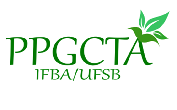Banca de DEFESA: THIARA HELENA MOTA ALMEIDA
Uma banca de DEFESA de MESTRADO foi cadastrada pelo programa.DISCENTE : THIARA HELENA MOTA ALMEIDA
DATA : 31/10/2019
HORA: 09:00
LOCAL: Campus Sosígenes Costa - Sala Taperapuã 1 - Link: https://mconf.rnp.br/webconf/csc-2
TÍTULO:
INTERRELATIONS BETWEEN SOIL USE AND OCCUPATION AND INDICATORS OF SOCIO-ECONOMIC DEVELOPMENT IN THE IDENTITY TERRITORY OF THE SOUTH BAHIA
PALAVRAS-CHAVES:
Land use and occupation, socioeconomic data, temporal evolution
PÁGINAS: 55
GRANDE ÁREA: Outra
ÁREA: Ciências Ambientais
RESUMO:
Unorganized urban growth and its consequences in the countryside, such as industrial agriculture and monoculture, are the main causes of land use problems. In this way, the monitoring and temporal evaluation of land use and occupation are fundamental for planning and restructuring of the territory on a sustainable basis. Through knowledge of land use, it is possible to acquire information about the conservation and anthropization levels of a given area. Based on this problem, the objective was to analyze the influence of changes in land use and occupation on the socioeconomic development of municipalities in the far south of Bahia, which has been undergoing various social and economic transformations throughout its history with the exploitation of natural resources. and land occupation. Land use and occupation data from the years 1990, 1994, 2002, 2006 and 2013, provided by the Far South Forest Forum of Bahia, and socioeconomic data from 1991, 2000 and 2010, obtained from the Development Atlas were used. FromBrazil, being correlated by Pearson's correlation (r), by matching the land use and occupation data with the socioeconomic data of 1990/1991, 2002/2000 and 2013/2010, respectively, in order to quantify the changes in the region. The territory of Alcobaça revealed eucalyptus as the class with the largest territorial occupation between 1990 and 2013. Caravelas, Mucuri and Nova Viçosa predominated with dirty pasture, but the highest growth class is eucalyptus. The cities Itamaraju, Jucuruçu and Prado showed the greatest degradation index, as the forest areas were replaced by pasture. The dynamics of the soil, in general, demonstrated the gradual increase of monoculture in the region to the detriment, above all, of pastures, forests in different stages and in smaller scale, of agriculture. In the correlation analysis of the influence of changes in land use and occupation and socioeconomic development, it was noted that the increase in the HDI accompanied the increase in areas of eucalyptus monoculture, as well as the increase in pasture quality, change of dirty pasture. through the clear pasture. The reduction in inequality, GINI index, also had a very similar behavior. In general, it is observed that the increase of socioeconomic development accompanied a strongenvironmental degradation, which suggests that the economic development model adopted in the municipality is based on the loss of environmental quality. Given this, there is a need to build another development model, which considers sustainability in its social and cultural aspects, because this model has strong pressure on the environment and its loss of quality.
MEMBROS DA BANCA:
Interno - 3072612 - ELFANY REIS DO NASCIMENTO LOPES
Externo ao Programa - 2250633 - FREDERICO MONTEIRO NEVES
Presidente - 1932539 - JOAO BATISTA LOPES DA SILVA
Externo ao Programa - 1212987 - PAULO DIMAS ROCHA DE MENEZES



